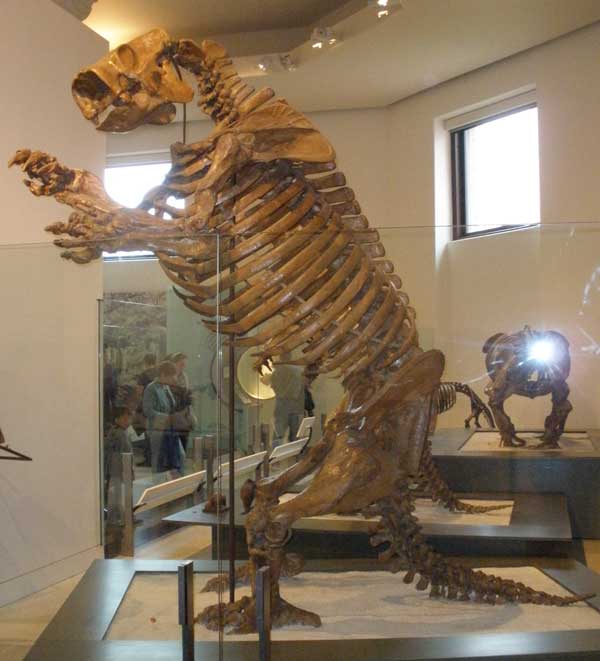
Lestodon armatus
Superregnum: Eukaryota
Cladus: Unikonta
Cladus: Opisthokonta
Cladus: Holozoa
Regnum: Animalia
Subregnum: Eumetazoa
Cladus: Bilateria
Cladus: Nephrozoa
Superphylum: Deuterostomia
Phylum: Chordata
Subphylum: Vertebrata
Infraphylum: Gnathostomata
Megaclassis: Osteichthyes
Cladus: Sarcopterygii
Cladus: Rhipidistia
Cladus: Tetrapodomorpha
Cladus: Eotetrapodiformes
Cladus: Elpistostegalia
Superclassis: Tetrapoda
Cladus: Reptiliomorpha
Cladus: Amniota
Cladus: Synapsida
Cladus: Eupelycosauria
Cladus: Sphenacodontia
Cladus: Sphenacodontoidea
Cladus: Therapsida
Cladus: Theriodontia
Cladus: Cynodontia
Cladus: Eucynodontia
Cladus: Probainognathia
Cladus: Prozostrodontia
Cladus: Mammaliaformes
Classis: Mammalia
Subclassis: Trechnotheria
Infraclassis: Zatheria
Supercohors: Theria
Cohors: Eutheria
Infraclassis: Placentalia
Superordo: Xenarthra
Ordo: Pilosa
Subordo: Folivora
Familia: †Mylodontidae
Genus: Lestodon
Lestodon armatus is the largest known mylodontid sloth.[10] Volumetric estimates suggests a body mass of around 4,100 kilograms (9,000 lb),[11] making it one of the largest known ground sloths, alongside the megatheres Megatherium and Eremotherium.[12]
Skull
Skull in side-on view
The skull of Lestodon armatus has a very wide muzzle. The premaxilllae are weakly attached to the maxillae (often resulting in them being absent in recovered fossils). The nasal septum was think and weak, and is rarely preserved. The nasal cartilage was apparently not ossified.[13] The roof of the muzzle is marginally concave along its midline. The maxilla extends more towards the front of the skull on its lower part. The nasofrontal suture is U-shaped, and opens forwards. The foramen magnum is oval-shaped.[3] The teeth were quite hypsodont (high-crowned), though not to the same degree as achieved in some other mylodontids.[14] At the front of the mouth there were two pairs of tusk-like "caniniform" teeth on the upper and lower jaws which are separated from the molariform teeth by a large diastema (gap).[3] The lower caniniform teeth appear to exhibit sexual dimorphism in regard to size.[15] The molariform teeth are largely similar to each other, aside from the last lower molar "which has two rounded lobes separated by a narrow constriction giving it a figure-8 shape".[3] There are 5 and 4 teeth in each half of the upper and lower jaw respectively, as is typical of mylodontids.[15]
Axial skeleton
The first thoracic vertebra has a much higher neural spine than the seventh cervical vertebra.[16]
Limbs
The olecranon process of the ulna of Lestodom armatus is slightly short compared to body size, though large in absolute terms.[11] The tibia and fibula of L. armatus are fused together at the end closest to the hip (proximal).[17] The tibia is relatively short compared to body size.[4] Like many other ground sloths, the foot is inwardly rotated, meaning that the weight was borne on the outer digits of the foot as well as on the calcaneus.[18] Like other ground sloths, the hands had ungual phalanges indicating well-developed claws.[19]
Distribution
Lestodon armatus is primarily known from the Pampas and the Chaco-Paraná Basin, including what is now southern Brazil, Paraguay, Uruguay, and northern Argentina.[20][21]
Retrieved from "http://en.wikipedia.org/"
All text is available under the terms of the GNU Free Documentation License

